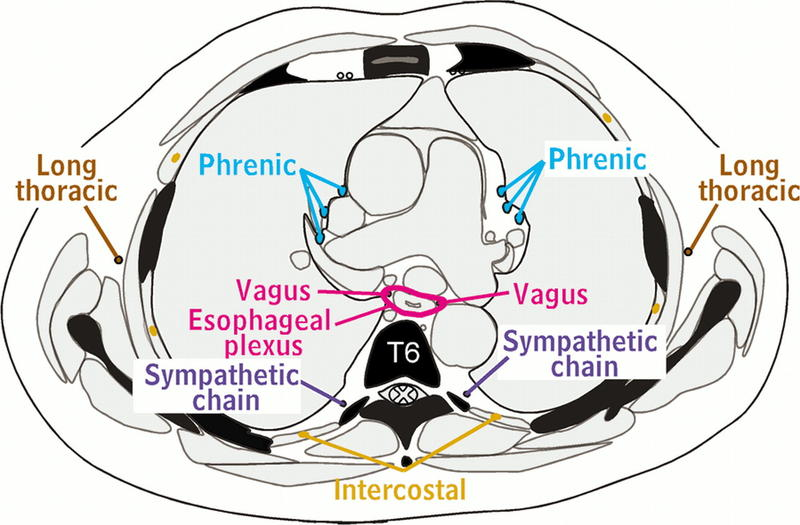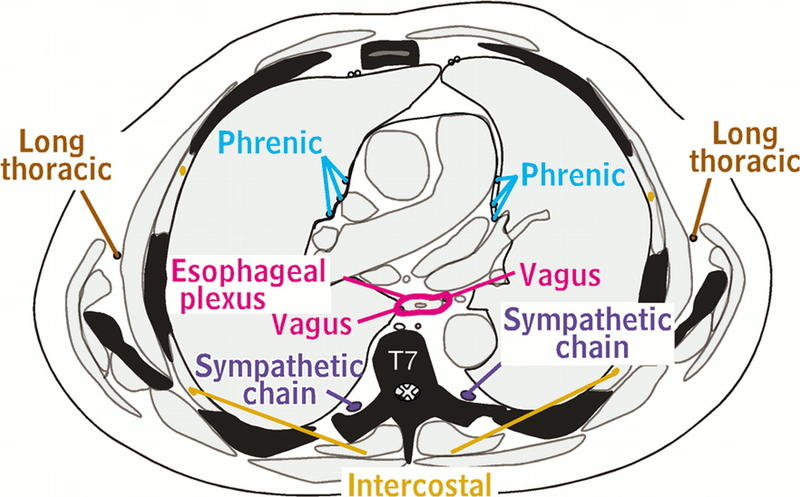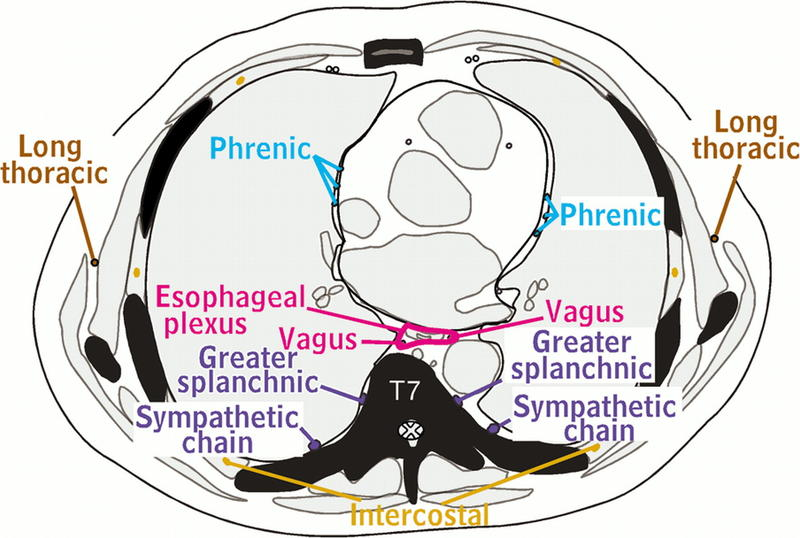
Anatomy, Thorax, Medial Pectoral Nerves
- Article Author:
- Kenia Maldonado
- Article Editor:
- Prasanna Tadi
- Updated:
- 10/28/2020 1:09:38 AM
- For CME on this topic:
- Anatomy, Thorax, Medial Pectoral Nerves CME
- PubMed Link:
- Anatomy, Thorax, Medial Pectoral Nerves
Introduction
The medial pectoral nerve, which is also known as the medial anterior thoracic nerve, arises as a branch of the medial cord of the brachial plexus with fibers originated from the eighth cervical and first thoracic nerve roots, and runs along the lower border of the pectoralis minor muscle, supplying it and also supplying the lower half of the pectoralis major muscle by its distal branch.[1] Sometimes there may be anatomical variations where the medial pectoral nerve arises from the anterior division of the inferior trunk of the brachial plexus, and less frequently from the lower trunk.
Structure and Function
The medial pectoral nerve passes around the lower border of the pectoralis minor muscle to then innervate the pectoralis major muscle to provide motor innervation. The pectoralis major muscle consists of a clavicular part and a sternal part. The sternal portion receives innervation from the medial pectoral nerve, which functions to extend the arm at the shoulder from a flexed position. Due to the insertion of the pectoralis minor muscle to the coracoid apophysis, this muscle helps to produce a medial rotation of the scapula against resistance, with the scapula and the upper limb fixed. Therefore, an injury to the medial pectoral nerve can lead to an inability to elevate the shoulder. The pectoralis minor muscle can also work as an accessory muscle for forced inspiration.
The medial pectoral nerve arises from the medial cord of the brachial plexus and through it from C8, and T1 roots usually pierce and supply the pectoralis minor.[2] There are two main patterns of branching of this nerve. In one of them (more frequent), the nerve pierced the deep aspect of the pectoralis minor muscle as a single trunk, ramified in the muscle, and gave some branches that appeared on the superficial aspect to enter the pectoralis major. In the other pattern, the nerve divide before entering pectoralis minor and its branches pass through the muscle or round its lower border to reach pectoralis major.[3] The origin of the medial pectoral nerve directly from the middle trunk of brachial plexus has not been reported until now.[4]
Embryology
The medial pectoral nerve is a peripheral nerve that arises from the brachial plexus. The brachial plexus is formed by the ventral rami of C5 through T1 to form trunks. The trunks form anterior and posterior divisions, which in turn form cords, and the cords end as terminal branches. The neuroectoderm differentiates from the ectoderm to the neural plate, the neural plate folds in upon itself to form the neural tube, this process is called neurulation, and the neural crest cells located at the most dorsal portion subsequently undergo an epithelial to mesenchymal transition, delaminate from the neural tube and begin to migrate to different and sometimes distant regions of the embryo.[5] The primordium of the dorsal nerves ends at the level of the humerus, which is the location of the sheath of the primordium of the muscles of the arm. On day 32, nerve extensions form from C5-T1, and on day 33, the nerves join together, and the plexus brachialis begins to form. A similar provision and orientation of the plexus brachialis to that of the adult are observable by days 49 and 50. The abundant anastomosis of the nerve roots from the fourth cervical through the first thoracic segment marks a primitive brachial plexus, where the medial pectoral nerve arises from its medial cord.
Blood Supply and Lymphatics
The axillary artery is closely related to the cords of the brachial plexus.[6] The medial pectoral nerve, which comes from the medial cord, is located close to the axillary artery. The medial pectoral nerve lies posteriorly to the axillary artery and then passes between the axillary artery and vein. The axillary lymph nodes drain the arm, the walls of the thorax, the mammary gland, and the upper walls of the abdomen. Therefore, the axillary nodes also receive lymph from the pectoralis minor muscle and the sternal portion of the pectoralis major muscle that is the region innervated by the medial pectoral nerve.
Nerves
The ventral rami of C5 through T1 form the brachial plexus. The ventral rami of C5 through T1 form the brachial plexus, and the lateral and medial pectoral nerves come from the lateral and medial cord, respectively.
The medial pectoral nerve forms an anastomosis with other nerves to share the innervation of other structures, this is the case of communication of the lateral pectoral nerve with the medial pectoral nerve, they together form a loop called the ansa pectoralis, and therefore the lateral pectoral nerve also contributes to the pectoralis minor muscle innervation.[2]
Muscles
The medial pectoral nerve innervates the lower parts of the pectoralis major and the pectoralis minor muscle; both contribute to the thoraco-brachial motion. The pectoralis major is a fan-shaped muscle located across the upper chest from the shoulder to the sternum, and it is the most superficial muscle in the pectoral region. The pectoralis minor muscle lies beneath the pectoralis major muscle, and it inserts superolateral into the coracoid process of the anterior scapula and anteromedially into the third, fourth, and fifth ribs.[7] There are accessory muscles of the shoulder girdle such as pectoralis quartus, chondrofascialis, axillary arch, chondroepitrochlearis, and sternalis muscles, that may be innervated by the medial pectoral nerve as well.[8]
Physiologic Variants
The reports of variants of the medial pectoral nerve are scanty because they are less frequent than, for example, the variants of lateral pectoral nerve. It is most likely to arise from the medial cord, but sometimes it can arise from the anterior division of the lower trunk, and less frequently, the medial pectoral nerve can arise directly from the trunk of the brachial plexus. There are reports of an origin from the C6 root and the anterior division of the middle trunk, but there were no reports of origins directly from the middle trunk of brachial plexus has not been reported until now.[4]
Surgical Considerations
The pectoral nerves may suffer injury by direct trauma, muscle compression, and in iatrogenic scenarios such as breast surgery, axillary node dissection, and pectoralis major muscle transfers, but surgical recovery is possible through nerve transfers. The surgical approach to the medial pectoral nerve is from either the supraclavicular or the infraclavicular route at the level of the medial cord, that's why its surgical accessibility, expandability, and the high number of motor fibers make it an attractive donor nerve for upper plexus injuries.[8] On the other hand, there are different opinions about the use of the medial pectoral nerve as a viable motor donor for brachial plexus injuries. Though no universal consensus exists, reports exist of favorable results, for example, in the restoration of elbow flexion, shoulder abduction, and improved serratus anterior strength with transfer to the musculocutaneous nerve, axillary nerve, and long thoracic nerve, respectively, when using the medial pectoral nerve as a donor.[9]
As mention in other sections, most of the times the medial pectoral nerve courses through the pectoralis minor muscle, whereas other times it exits around the lateral aspect of this muscle, so we can infer that if the surgeon dissects between the pectoralis major and pectoralis minor muscle, he is likely to disrupt a portion of the innervation to the pectoralis major muscle.
Clinical Significance
The modified radical mastectomy has become more common among the surgeries for breast cancer.[10] Surgeons should avoid the medial pectoral nerve and the thoracoacromial vessel branches found at the apex of the axillary space during the removal of the lymph nodes. In some procedures such as mastectomy and shoulder dislocations, a neurovascular blockage of the medial and lateral nerves is necessary to reduce post-operative pain and muscle spasm.[4] Even in breast augmentation using breast implants, or in the transfer of the pectoralis major muscle in myocutaneous free flap surgery, the cosmetic surgeons have to know the exact topography of these nerves and their possible variations.[1]
Other Issues
The medial pectoral nerve can be used for nerve transfer procedures, known as neurotization, to restore the function of the shoulder after the injury of the upper trunk of the brachial plexus.[9] Nerve transfer has better outcomes because it does not alter the shoulder's muscular biomechanics as tendon transfer does, so it has a greater potential for functional recovery.[11] For this type of injury, the primary purpose is to focus on the stabilization of the shoulder with the restoration of shoulder abduction and external rotation because the most distal functions depend on the functionality and stability of the shoulder.[12]
(Click Image to Enlarge)
(Click Image to Enlarge)


